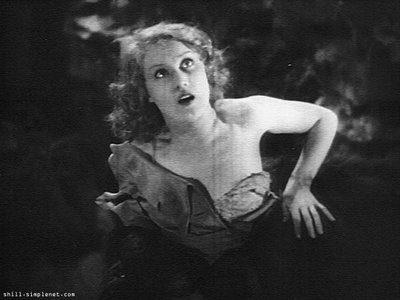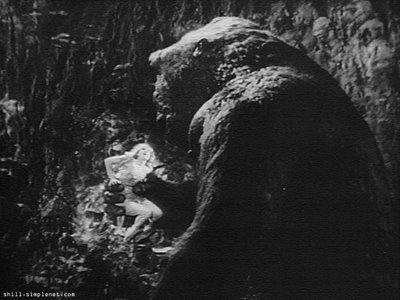What more can possibly be said of the original KING KONG? It's the grand-daddy of all giant monster movies and a landmark in both American cinema and general Americana, a work whose impact still reverberates nearly a century after its release. Everyone knows its plot particular, but it can be broken down thusly: A film crew makes an expedition to an uncharted island in the South Seas, where they find a gigantic ape that is worshiped as a god by the natives, and the director intends to shoot a movie about the beast. The woman who is along as the star of the film is abducted by the natives as a sacrifice to the ape, who carries her away through a jungle filled with deadly prehistoric animals to his mountain top lair, and the film crew and ship's compliment give pursuit, many losing their lives in the process. When the woman is rescued and brought back, the ape follows and is brought down by the film crew's gas bombs. Ferried back to New York City, the beast is put on display as an attraction for the city's affluent, but the creature escapes and goes on a deadly rampage until it finds the woman again and carries her to the highest point in the city. It is there that the monster meets its fate.
That description is basically what happens, but it in no way communicates the richness of the film's black-and-white visuals, its then groundbreaking stop-motion visual effects, its surprising level of adventure, action and violence, Kong being something of a sympathetic terror — after all, it was the white men who invaded his domain and kidnapped him with an end goal of what amounts to enslavement — and enough subtext to fuel decades of interpretation of the narrative's "true" intent. KING KONG is a work that was way ahead of its time in every way, while still being very much a product of its era in terms of now "problematic" content regarding race and handling of its female character, so newcomers are advised to approach it with what was acceptable back in 1933 firmly in mind.
AS previously documented, I was a monster kid from Day One, but I never saw the original KING KONG until I was eight years old, five years after being exposed to the character of Kong via Saturday morning reruns of the 1966 Japanese animated Rankin-Bass cartoon show in which Kong was a hero who is befriended by a young boy, and also the 1967 Toho film, KING KONG ESCAPES, which brought Kong into the landscape of Japanese kaiju. I loved both, but I did not experience the real deal until it was released in a restored version in 1973. My mother knew and understood my love of monsters, so when she heard of the grand-daddy of them all coming back to the screen, she took me as a treat. My mind was blown, and though I was raised in a socially-conscious Black household, I was still too young to parse the movie as anything other than a riveting adventure movie that happened to feature a rampaging 30-foot gorilla. The "problematic" elements did not register at all, such was the power of the story being told.
Following that inaugural screening, I saw KING KONG on a yearly basis, as it became a perennial constant on WOR, Channel 9 out of Secaucus, New Jersey. During the pre-cable years, it aired every year on Thanksgiving as part of a two-day package of giant ape and monster movies intended to give the kiddies something to do when the holiday feasting was over and the adults watched football in another room and/or got their drink on. That day was sometimes looked forward to more than the family gathering with all of the slaved-over banquet, because we got KING KONG, SON OF KONG, and MIGHTY JOE YOUNG on the first day (though some years began the festival with MIGHTY JOE YOUNG), followed by three random Godzilla movies (usually a trio of the lesser ones) on the following day.
 In 2004, when word of Fay Wray, leading lady
in the classic 1933 version of KING KONG, screamer extraordinaire and
the cinema’s quintessential damsel in distress, passing away at age 96 hit, film fans worldwide were devastated. The black and white
image of her stunning blonde beauty, adorned in naught but a torn teddy
while struggling to escape the fearsome-yet-adoring clutches of the
thirty-foot monster god of an uncharted island had at that point been carved in stone
as a cinematic landmark for seventy-one years and is unforgettable proof
of the dream machine that was once the Golden Age of Hollywood.
In 2004, when word of Fay Wray, leading lady
in the classic 1933 version of KING KONG, screamer extraordinaire and
the cinema’s quintessential damsel in distress, passing away at age 96 hit, film fans worldwide were devastated. The black and white
image of her stunning blonde beauty, adorned in naught but a torn teddy
while struggling to escape the fearsome-yet-adoring clutches of the
thirty-foot monster god of an uncharted island had at that point been carved in stone
as a cinematic landmark for seventy-one years and is unforgettable proof
of the dream machine that was once the Golden Age of Hollywood.
Upon
hearing of Miss Wray’s passing the first thing that crossed my mind was
“Was she the last person involved in KING KONG to go?” If she was, she
may have been the last of a dying breed, the old-school Hollywood movie
star. When one thinks of those who pass for stars these days, that’s a
sad thought indeed. Will Keanu Reeves, Brittany Murphy or even Adam
Sandler be remembered down the line with the fondness afforded Wray and
her contemporaries? I sincerely doubt it, and that’s ironic since Wray
publicly bemoaned the fact that the mythic status of her role in KING
KONG lead to the overshadowing of every other part she essayed. With
the unabashed love that I have for giant monster films, it should come
as no surprise to anyone that the 1933 KING KONG is my favorite movie. I
say movie because film is a somewhat lofty term often applied to works
by artists such as Bergman, Kurosawa and Jarmusch, items of deep
examination of the human condition and such. Not so with KONG. KING KONG
is a rollicking piece of entertainment, sheer fun from start to finish,
with nothing on its mind except entertaining its audience and placing
the viewer firmly within an adventure into the fantastic. Fun and
entertainment is what it’s all about, and by those criteria KING KONG is
a great movie.
With
the unabashed love that I have for giant monster films, it should come
as no surprise to anyone that the 1933 KING KONG is my favorite movie. I
say movie because film is a somewhat lofty term often applied to works
by artists such as Bergman, Kurosawa and Jarmusch, items of deep
examination of the human condition and such. Not so with KONG. KING KONG
is a rollicking piece of entertainment, sheer fun from start to finish,
with nothing on its mind except entertaining its audience and placing
the viewer firmly within an adventure into the fantastic. Fun and
entertainment is what it’s all about, and by those criteria KING KONG is
a great movie.
A
Depression-era adventure yarn like no other, KING KONG has mood,
romance, thrills and balls-out monster action from start to finish and
several sequences that have since become ingrained into the worldwide
popular culture. And considering that Kong himself has existed on his
island for thousands of years, I have always wondered what his typical
day was like. During the harrowing adventure shared by Anne Darrow and
Jack Driscoll deep within the teeming jungle of Skull Island, we see
Kong handing out ass-whuppings on his fellow jungle denizens like it was
Halloween candy. Remove the two hapless humans from that picture and
you have to realize that Kong’s day-to-day existence would have sucked
most egregiously when he wasn’t being offered native women with which to
do God only knows what. I can see it now: the big guy is lumbering down
a dense forest path when, suddenly, some primordial crawly thing drops
out of a tree and attempts to eat his face. Kong savagely dispatches
this creature and continues on his mighty way. Then, without warning, a
Tyrannosaurus Rex jumps out of a ditch and tries to bite his nuts off.
Our giant-ape-about-town puts much foot to scaly ass and vanquishes the
errant T-Rex by ripping off its head and taking a big dump down its
throat. After foraging for whatever may constitute the diet of a
thirty-foot primate, Kong returns to his mountain top lair to chill out
and relax. As he reclines and begins to nod off to Slumberland, a giant
carrion bird swoops from the skies and tries to lodge its beak up Kong’s
hairy ass. Kong clenches his titanic butt-cheek muscles, breaking the
bird’s neck like a Mister Salty pretzel stick. Kong then stands atop the
corpse, throws back his head and drums on his chest. He lets out a cry
of what may appear to be triumph, but he’s more likely saying “Can’t I
go through just one day without somebody trying to eat my ass??? FUCK MY LIFE!!!”
In
honor of Fay Wray’s passing, I watched the film again that night, and
it was sort of like attending the wake of someone I’d known since
childhood. I just wish that I could have invited everyone I know over to
share it with me. In short, the 1933 KING KONG is quintessential seminal giant monster cinema and should be experienced by every true lover of movies, and especially of monster movies in particular. A landmark of 20th Century Americana in no uncertain terms.
In short, the 1933 KING KONG is quintessential seminal giant monster cinema and should be experienced by every true lover of movies, and especially of monster movies in particular. A landmark of 20th Century Americana in no uncertain terms.



No comments:
Post a Comment